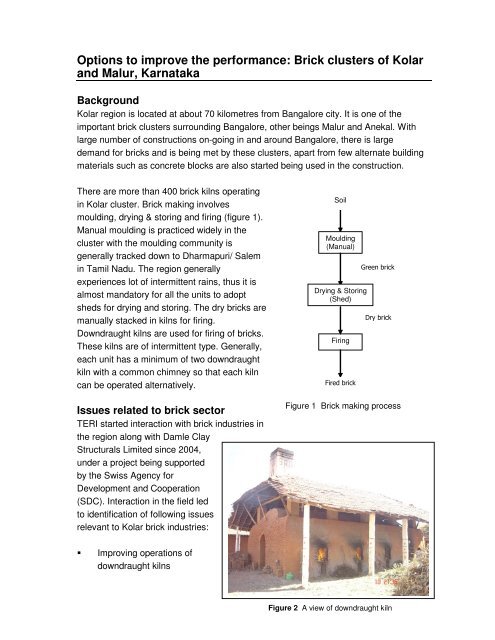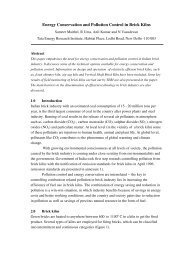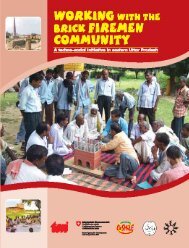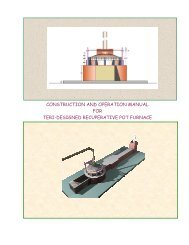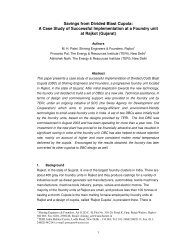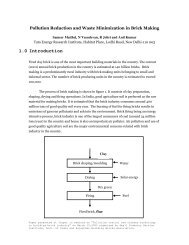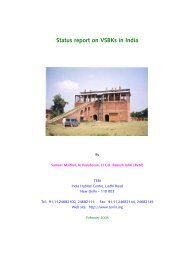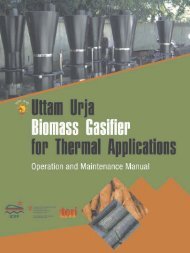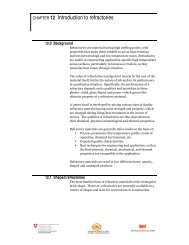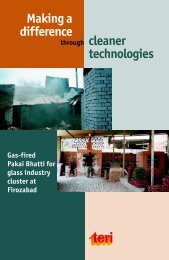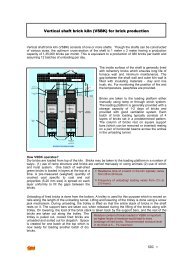Options to improve the performance: Brick clusters of ... - Cosmile.org
Options to improve the performance: Brick clusters of ... - Cosmile.org
Options to improve the performance: Brick clusters of ... - Cosmile.org
You also want an ePaper? Increase the reach of your titles
YUMPU automatically turns print PDFs into web optimized ePapers that Google loves.
<strong>Options</strong> <strong>to</strong> <strong>improve</strong> <strong>the</strong> <strong>performance</strong>: <strong>Brick</strong> <strong>clusters</strong> <strong>of</strong> Kolar<br />
and Malur, Karnataka<br />
Background<br />
Kolar region is located at about 70 kilometres from Bangalore city. It is one <strong>of</strong> <strong>the</strong><br />
important brick <strong>clusters</strong> surrounding Bangalore, o<strong>the</strong>r beings Malur and Anekal. With<br />
large number <strong>of</strong> constructions on-going in and around Bangalore, <strong>the</strong>re is large<br />
demand for bricks and is being met by <strong>the</strong>se <strong>clusters</strong>, apart from few alternate building<br />
materials such as concrete blocks are also started being used in <strong>the</strong> construction.<br />
There are more than 400 brick kilns operating<br />
in Kolar cluster. <strong>Brick</strong> making involves<br />
moulding, drying & s<strong>to</strong>ring and firing (figure 1).<br />
Manual moulding is practiced widely in <strong>the</strong><br />
cluster with <strong>the</strong> moulding community is<br />
generally tracked down <strong>to</strong> Dharmapuri/ Salem<br />
in Tamil Nadu. The region generally<br />
experiences lot <strong>of</strong> intermittent rains, thus it is<br />
almost manda<strong>to</strong>ry for all <strong>the</strong> units <strong>to</strong> adopt<br />
sheds for drying and s<strong>to</strong>ring. The dry bricks are<br />
manually stacked in kilns for firing.<br />
Downdraught kilns are used for firing <strong>of</strong> bricks.<br />
These kilns are <strong>of</strong> intermittent type. Generally,<br />
each unit has a minimum <strong>of</strong> two downdraught<br />
kiln with a common chimney so that each kiln<br />
can be operated alternatively.<br />
Issues related <strong>to</strong> brick sec<strong>to</strong>r<br />
TERI started interaction with brick industries in<br />
<strong>the</strong> region along with Damle Clay<br />
Structurals Limited since 2004,<br />
under a project being supported<br />
by <strong>the</strong> Swiss Agency for<br />
Development and Cooperation<br />
(SDC). Interaction in <strong>the</strong> field led<br />
<strong>to</strong> identification <strong>of</strong> following issues<br />
relevant <strong>to</strong> Kolar brick industries:<br />
Soil<br />
Moulding<br />
(Manual)<br />
Drying & S<strong>to</strong>ring<br />
(Shed)<br />
Firing<br />
<br />
<br />
<br />
Figure 1 <strong>Brick</strong> making process<br />
<br />
Improving operations <strong>of</strong><br />
downdraught kilns<br />
Figure 2 A view <strong>of</strong> downdraught kiln
Enhancing drying <strong>of</strong> green bricks<br />
Better technological options for brick making<br />
Addressing <strong>the</strong>se issues was felt crucial for moving <strong>to</strong>wards <strong>improve</strong>d <strong>performance</strong> <strong>of</strong><br />
<strong>the</strong> cluster. With this in view, TERI attempted <strong>to</strong> introduce changes in <strong>the</strong> cluster<br />
through demonstration.<br />
<strong>Options</strong> <strong>to</strong> <strong>improve</strong> <strong>performance</strong> <strong>of</strong> brick kiln units<br />
(1) Improving operations <strong>of</strong> downdraught kilns<br />
Existing operating practices<br />
In downdraught kilns, dry bricks are<br />
stacked, fired, cooled and taken out. These<br />
kilns are generally constructed with red<br />
bricks with <strong>the</strong> inner layer being refrac<strong>to</strong>ry<br />
bricks. Thickness <strong>of</strong> <strong>the</strong> wall is about 5 feet.<br />
The <strong>to</strong>tal cycle time required for loading <strong>of</strong><br />
green bricks <strong>to</strong> cooling <strong>of</strong> fired bricks is<br />
about 7 days. Production capacity <strong>of</strong><br />
downdraught kilns range between 20,000 <strong>to</strong><br />
40,000 bricks per batch operation. There<br />
are about 12 fireboxes in a downdraught<br />
kiln, with 6 fireboxes located on each side.<br />
Figure 5 shows sketch <strong>of</strong> a downdraught<br />
kiln.<br />
Figure 3 Existing firing practices<br />
Dry bricks are stacked in <strong>the</strong> downdraught<br />
kilns. Generally, no gap is provided<br />
between bricks and <strong>the</strong> wall <strong>of</strong> <strong>the</strong> kiln. The<br />
openings are sealed <strong>of</strong>f and firing is<br />
initiated. Eucalyptus branches and firewood<br />
are used as fuels for firing <strong>of</strong> bricks. Fuel is<br />
fed from all fireboxes from both sides; firing<br />
is continued till a temperature <strong>of</strong> about<br />
500 o C is attained. Experiences <strong>of</strong> <strong>the</strong><br />
opera<strong>to</strong>r judge <strong>the</strong> temperature by<br />
observing colour <strong>of</strong> bricks. Temperature<br />
moni<strong>to</strong>ring is not in practice in <strong>the</strong> cluster.<br />
Upon reaching this temperature, fire boxes<br />
located on one side <strong>of</strong> <strong>the</strong> kiln are<br />
Figure 4 Stack emission from a downdraught kiln
completely shut <strong>of</strong>f; fuel feeding is continued with fireboxes on <strong>the</strong> o<strong>the</strong>r side.<br />
Continuous feeding <strong>of</strong> fuel without moni<strong>to</strong>ring temperatures results in deficiency in<br />
availability <strong>of</strong> combustion air, causing formation <strong>of</strong> unburnts and smoke. The key<br />
operating parameters in a downdraught kiln are shown in table 1.<br />
Table 1 Key operating parameters <strong>of</strong> existing downdraught kiln<br />
Production<br />
32,500 bricks per cycle<br />
Weight <strong>of</strong> bricks (average)<br />
3.6 kg<br />
Cycle period<br />
Total : 7 <strong>to</strong> 9 days<br />
Heating :1 <strong>to</strong> 1½ days<br />
Stacking, cooling & unloading : 6 <strong>to</strong> 7½ days<br />
Fuel consumption per production cycle 17.8 <strong>to</strong>nne per cycle<br />
Specific energy consumption*<br />
9.3 MJ/ kg fired brick<br />
Saleable bricks 90-93 %<br />
Total fuel costs<br />
Rs 21,360 per cycle<br />
Source: Based on actual moni<strong>to</strong>ring carried out by TERI at Bagavahi <strong>Brick</strong> Industry, Malur<br />
* Specific energy consumption is <strong>the</strong> energy required <strong>to</strong> fire one kilogram <strong>of</strong> brick<br />
Assumptions:<br />
(1) GCV <strong>of</strong> wood = 2000 kcal/kg; (2) GCV <strong>of</strong> eucalyptus branches : 4466 kcal/kg (18.7 MJ/kg);<br />
(3) Cost <strong>of</strong> eucalyptus branch/ firewood = Rs 1200 per <strong>to</strong>nne<br />
Sketch <strong>of</strong> Down Draft Kiln (DDK)<br />
Sno. Name <strong>of</strong> part<br />
1 Top <strong>of</strong> DD kiln<br />
2 Firing port<br />
3 Flue gas chimney<br />
4 Damper<br />
5 Flue gas path<br />
6 <strong>Brick</strong> loading space<br />
7 Flue gas entering gap
1<br />
3<br />
7<br />
6<br />
2<br />
5<br />
4<br />
Figure 5 Sketch <strong>of</strong> a downdraught kiln<br />
Improved or best operating practices<br />
Improving <strong>the</strong> operating practices in a<br />
downdraught kiln was demonstrated in one<br />
<strong>of</strong> <strong>the</strong> units in <strong>the</strong> Kolar cluster, which<br />
involved <strong>the</strong> following:<br />
Quantification <strong>of</strong> various inputs such<br />
as weight <strong>of</strong> bricks and fuel<br />
consumption before and after firing.<br />
<br />
<br />
Fuel savings up<strong>to</strong> 20%<br />
Reduction in firing cycle – 2 <strong>to</strong> 3<br />
hours<br />
Reduced formation <strong>of</strong> overburnt<br />
and under-burnt bricks<br />
Adopting uniform fuel feeding pattern depending on temperature requirements <strong>to</strong><br />
enable uniform distribution <strong>of</strong> heat and highest possible heat transfer.<br />
Continuous moni<strong>to</strong>ring <strong>of</strong> temperatures <strong>of</strong> firing zone (in few selected locations)<br />
and flue gas temperature using <strong>the</strong>rmocouples.<br />
Adoption <strong>of</strong> best operating practices (BOP) helped in saving fuel (energy) consumption,<br />
up<strong>to</strong> <strong>the</strong> extent <strong>of</strong> 20%, improving product quality and reducing heat losses. Following<br />
observations were made while demonstrating best operating practices in downdraught<br />
kiln (table 2).
Table . Improved operating parameters with best operating practices<br />
Fuel consumption per production cycle 15.8<br />
Temperature <strong>of</strong> fired bricks<br />
Specific energy consumption<br />
800-850 o C<br />
7.4 MJ/ kg fired brick<br />
Saleable bricks 95-98%<br />
Fuel savings 20%<br />
Recommendations for best operating practices in downdraught kiln<br />
Based on <strong>the</strong> demonstration carried out at Bagavathi <strong>Brick</strong>s, Malur, following operating<br />
practices are recommended which would help in improving <strong>the</strong> operating <strong>performance</strong><br />
<strong>of</strong> downdraught kilns and attain fuel savings.<br />
Recommendation-1: Leave gap between bricks and kiln wall<br />
A gap <strong>of</strong> about 100 mm must be provided between bricks kept for firing and <strong>the</strong> wall <strong>of</strong><br />
downdraught kiln. This would enable <strong>the</strong> fire <strong>to</strong> travel without obstructions and <strong>improve</strong><br />
uniform distribution <strong>of</strong> heat between various sections <strong>of</strong> <strong>the</strong> kiln. Uniform distribution <strong>of</strong><br />
heat would reduce over-firing or under-firing <strong>of</strong> bricks or formation <strong>of</strong> black cores.<br />
Recommendation-2: Operate fireboxes<br />
and damper based on requirements<br />
Upon initiating firing in a downdraught kiln, it is<br />
necessary <strong>to</strong> increase <strong>the</strong> temperature <strong>to</strong><br />
release water from brick body and soak at<br />
temperatures based on composition <strong>of</strong> soil used<br />
<strong>to</strong> complete chemical reactions. To enable this, it<br />
is recommended <strong>to</strong> install <strong>the</strong>rmocouples <strong>to</strong><br />
moni<strong>to</strong>r <strong>the</strong> temperature <strong>of</strong> <strong>the</strong> kiln inside.<br />
(i) Operation up<strong>to</strong> 500 o C<br />
Initial heating up<strong>to</strong> 500 o C is done gradually. This<br />
means measured quantity <strong>of</strong> fuel must be fed at<br />
constant rate for removal <strong>of</strong> mechanically held<br />
water and <strong>the</strong>n chemically held water. Dampers<br />
must be open <strong>to</strong> aid this process. Fuel<br />
feeding is done through half number <strong>of</strong> <strong>the</strong><br />
fireboxes, with remaining half must be kept<br />
closed until a temperature <strong>of</strong> 500 o C is<br />
Figure 6<br />
Temperatur<br />
es vs colour<br />
chart<br />
reached. For example if <strong>the</strong> kiln has 12 fireboxes, 6 fireboxes must be used. It is also<br />
recommended that alternate fireboxes must be used during this phase.
(ii) Operation from 500 o C onwards<br />
With <strong>the</strong> removal <strong>of</strong> chemically held water, <strong>the</strong> firing rate is increased. Fuel feeding<br />
must be continued from all fireboxes on both sides <strong>of</strong> <strong>the</strong> kiln. Damper openings must<br />
be reduced <strong>to</strong> retain heat inside and temperature inside <strong>the</strong> kiln for maximizing heat<br />
transfer <strong>to</strong> <strong>the</strong> bricks. During this stage, flue gas heat losses are also reduced due <strong>to</strong><br />
reduced air flow. The firing temperature <strong>of</strong> bricks in Kolar region is about 800-850 o C.<br />
1000<br />
900<br />
Firing must be continued from<br />
all sides <strong>to</strong> enable soaking<br />
<strong>of</strong> bricks for about 3 hours<br />
in <strong>the</strong> same temperature<br />
range. Firing is s<strong>to</strong>pped at<br />
this point and all fire boxes<br />
are closed. Figure 7 shows a<br />
typical temperature pr<strong>of</strong>ile in a<br />
downdraught kiln in Kolar<br />
cluster.<br />
Temperature ( o C)<br />
800<br />
700<br />
600<br />
500<br />
400<br />
300<br />
200<br />
100<br />
0<br />
7.00 am<br />
8.00am<br />
9.00am<br />
10.00 am<br />
11.00am<br />
12.00 noon<br />
1.00pm<br />
2.00pm<br />
3.00pm<br />
4.00pm<br />
5.00pm<br />
6.00pm<br />
7.00pm<br />
8.00pm<br />
Time (hr)<br />
9.00pm<br />
10.00pm<br />
11.00pm<br />
12.00 mid<br />
1.00 am<br />
2.00am<br />
3.30am<br />
4.30am<br />
5.30am<br />
6.30am<br />
7.30am<br />
8.30am<br />
<br />
Figure 7 Typical temperature pr<strong>of</strong>ile in downdraught kiln<br />
(2) Enhancing drying <strong>of</strong> green bricks<br />
Freshly moulded bricks contain lot <strong>of</strong> water which need <strong>to</strong> be removed <strong>to</strong> reach lea<strong>the</strong>rhard<br />
conditions. This is required <strong>to</strong> ensure no deformation <strong>of</strong> shape takes place while<br />
handling as well as no breakage during heating. Typical conditions <strong>of</strong> bricks in Kolar<br />
cluster shows about 17% reduction in weight due <strong>to</strong> moisture removed from green<br />
bricks (table 3).<br />
Table 3. Weight <strong>of</strong> bricks<br />
Freshly moulded bricks or green bricks : 4.54 kg<br />
Dry bricks<br />
: 3.76 kg<br />
Fired bricks<br />
: 3.58 kg<br />
% weight reduction after drying : 17.3%<br />
% weight reduction after firing : 4.6%<br />
Existing drying cycle in Kolar and Malu <strong>clusters</strong>r<br />
The <strong>to</strong>tal duration for complete drying <strong>of</strong> bricks is 8 <strong>to</strong> 25 days depending on climatic<br />
conditions, starting from green brick moulding <strong>to</strong> before feeding inside <strong>the</strong> kiln for firing<br />
(table 4). Time requirements for drying increase during monsoon season.
Table 4 Weight <strong>of</strong> bricks<br />
Season<br />
Days<br />
Summer : 6 – 10<br />
Rainy : 20 – 25<br />
Winter : 15 - 18<br />
The needs and options for brick drying<br />
Large duration required for drying indicates requirements <strong>of</strong> large sheds and green<br />
brick inven<strong>to</strong>ry required at kiln site. Use <strong>of</strong> separate dryers <strong>to</strong> remove moisture from<br />
green bricks would greatly help in reducing <strong>the</strong> duration for brick drying. Since <strong>the</strong>se<br />
dryers are separate systems and use additional fuels <strong>to</strong> dry green bricks, <strong>the</strong>y are<br />
known as “artificial drying”. These artificial dryers would help in:<br />
Reducing duration required for green brick drying<br />
Enhancing productivity <strong>of</strong> <strong>the</strong> unit<br />
Reducing green brick inven<strong>to</strong>ry<br />
However, adoption <strong>of</strong> artificial drying would require additional investments. With <strong>the</strong> use<br />
<strong>of</strong> additional fuel, it would also increase <strong>the</strong> overall operating costs <strong>of</strong> <strong>the</strong> unit.<br />
Depending on <strong>the</strong> scale <strong>of</strong> operation, individual units may choose any one <strong>of</strong> <strong>the</strong><br />
methods for <strong>the</strong>ir benefits.<br />
(i) Artificial drying<br />
Artificial drying enhances availability <strong>of</strong> moisture-removed dry bricks for firing in <strong>the</strong> kiln.<br />
A number <strong>of</strong> dryers are available commercially, and <strong>the</strong> level <strong>of</strong> sophistication dictates<br />
<strong>the</strong> investments requirements. Most <strong>of</strong> <strong>the</strong> dryers also require power (electricity<br />
connection/ use <strong>of</strong> diesel generating sets) for operating blowers/ fans and/ or moving<br />
platform. Non-availability <strong>of</strong> quality power (availability and voltage level) may also be a<br />
constraint for majority <strong>of</strong> <strong>the</strong> brick kiln units which are generally located in rural areas.<br />
Figure 8 shows dryer will be used for removal <strong>of</strong> moisture from bricks before loaded<br />
inside <strong>the</strong> kiln. Types <strong>of</strong> artificial dryers available in <strong>the</strong> market are:<br />
Hot floor drying<br />
Tunnel dryer<br />
Waste heat dryer<br />
Chamber dryer<br />
Heap dryer
Moulded<br />
bricks<br />
Dryer Kiln Fired brick<br />
Shed<br />
Figure 8 Use <strong>of</strong> dryer in a brick kiln<br />
Efficiency levels <strong>of</strong> “hot floor drying” is very<br />
poor compared <strong>to</strong> o<strong>the</strong>r systems, and<br />
hence not preferable. Investment<br />
requirements for tunnel dryer are quite high<br />
for <strong>the</strong> level <strong>of</strong> brick production followed in<br />
Karnataka. Waste heat recovery system<br />
also may not be suitable as <strong>the</strong>y would<br />
require continuous source <strong>of</strong> flue gases for<br />
supply <strong>of</strong> waste heat which is not generally<br />
available in a brick kiln unit.<br />
Figure 9 Artificial stack dryer experimented by an<br />
“Heap/ stack drying” is similar <strong>to</strong> clamp<br />
entrepeneur at Malur<br />
firing. <strong>Brick</strong>s are stacked and heated with<br />
fuel fired from sides. Figure 9 shows some trials conducted by one <strong>of</strong> <strong>the</strong> brick kiln units<br />
in Malur. However, <strong>the</strong> disadvantages <strong>of</strong> heap drying are:<br />
Low <strong>the</strong>rmal efficiency i.e. require more fuel for drying<br />
Non-uniform heating <strong>of</strong> bricks<br />
Chamber dryers are intermittent drying systems following batch process. This is<br />
suitable for a medium size brick kiln unit. Approximate investments for a chamber dryer<br />
for a capacity <strong>of</strong> 1200 bricks per batch are Rs 3.5 lakh. The <strong>to</strong>tal cycle time for <strong>the</strong><br />
drying process in a chamber dryer is 50 hours.<br />
(ii) O<strong>the</strong>r options - Improving natural drying practices<br />
<strong>Brick</strong> kiln units in Kolar and Malur use extensively sheds which are used for drying as<br />
well as s<strong>to</strong>ring <strong>of</strong> bricks. Figure 8 shows a typical shed used in a brick kiln unit. A close<br />
look on <strong>the</strong> sheds used in <strong>the</strong> cluster indicated scope for <strong>improve</strong>ments <strong>to</strong> <strong>improve</strong> <strong>the</strong><br />
drying process. TERI demonstrated <strong>the</strong> benefits <strong>of</strong> adoption <strong>of</strong> <strong>improve</strong>d drying sheds<br />
in one <strong>of</strong> <strong>the</strong> brick kiln units at Malur.
Figure 10 Drying sheds used in Kolar/ Malur brick kiln units<br />
Recommindation-1: Direction <strong>of</strong> sheds<br />
Drying sheds are located in North-South direction as well as East-West direction,<br />
depending on <strong>the</strong> convenience <strong>of</strong> <strong>the</strong> unit. These sheds must be relocating mainly in<br />
East-West direction, <strong>to</strong> match with <strong>the</strong> direction <strong>of</strong> wind flow that would <strong>improve</strong> <strong>the</strong><br />
drying rates.<br />
Recommendation-2: Distance between adjacent sheds<br />
Most <strong>of</strong> <strong>the</strong> drying sheds inside a brick kiln unit are built close <strong>to</strong> each o<strong>the</strong>r with very<br />
little gap existing between. Closely located sheds reduce <strong>the</strong> rate <strong>of</strong> heat transfer. In<br />
each brick kiln unit, a space <strong>of</strong> about 5 feet must be left between adjacent sheds which<br />
would help in improving convection and hence removal <strong>of</strong> moisture.<br />
Recommendation-3: Enhancing solar heating with translucent/ glass tiles<br />
The sheds <strong>of</strong> brick kiln units in Kolar/ Malur are constructed with clay tiles. These tiles<br />
do not allow sun light <strong>to</strong> pass through. It is recommended that at least 3-5% <strong>of</strong> existing<br />
tiles in <strong>the</strong> sheds must be replaced with translucent tiles which would allow sunlight <strong>to</strong><br />
pass through and help in increasing drying rates. These glass tiles must also be<br />
staggered (e.g. zigzag pattern) <strong>to</strong> ensure availability <strong>of</strong> heat across different sections<br />
<strong>of</strong> <strong>the</strong> shed.<br />
Recommendation-4: Provision <strong>of</strong> hoods in ro<strong>of</strong><br />
None <strong>of</strong> <strong>the</strong> sheds in Kolar is provided with exhaust system at <strong>the</strong> ro<strong>of</strong> which would<br />
induce draught and circulation <strong>of</strong> fresh air inside <strong>the</strong> shed. The existing ro<strong>of</strong> structure<br />
must be fitted with hoods for removing moist air and allow flow <strong>of</strong> fresh air <strong>to</strong> enter<br />
inside.
Translucent/ Glass tiles<br />
Hoods<br />
s<br />
23 feet<br />
33 feet<br />
111 feet<br />
S<strong>to</strong>ne slabs (13 no.) <strong>of</strong> 7 feet length (2<br />
feet inside & 5 feet above ground level)<br />
S<strong>to</strong>ne slabs (13no) <strong>of</strong> 12 feet length (2feet<br />
inside and 10 feet above ground level)<br />
Figure 11 Improved drying sheds<br />
Incorporation <strong>of</strong> changes in <strong>the</strong> sheds is expected <strong>to</strong> enhance <strong>the</strong> drying rate by about<br />
30-35%. Figure 7 shows a sketch <strong>of</strong> an <strong>improve</strong>d drying shed. These modifications<br />
would require a marginal investment <strong>of</strong> about Rs 25,000 per shed <strong>of</strong> s<strong>to</strong>ring capacity <strong>of</strong><br />
30,000 bricks.<br />
(3) Use <strong>of</strong> additives <strong>to</strong> <strong>improve</strong> strength <strong>of</strong> green bricks<br />
Trials were conducted by TERI for use <strong>of</strong> additives, mainly sodium silicate in green<br />
brick making in one <strong>of</strong> <strong>the</strong> brick kiln units in Malur. It was observed that particularly <strong>the</strong><br />
number <strong>of</strong> handlings <strong>of</strong> green bricks is more in case <strong>of</strong> VSBK (vertical shaft brick kiln)<br />
as compared <strong>to</strong> traditional downdraught kilns. Therefore, <strong>the</strong> green bricks must have<br />
enough strength which o<strong>the</strong>rwise leads <strong>to</strong> more rejections (10-15%) due <strong>to</strong> chipping <strong>of</strong><br />
edges and warping <strong>of</strong> bricks. 2% sodium silicate (commercial grade) was added <strong>to</strong> <strong>the</strong><br />
water and mixed with <strong>the</strong> body homogeneously in one <strong>of</strong> <strong>the</strong> brick kiln units. Trials<br />
conducted at <strong>the</strong> brick kiln unit at Malur led <strong>to</strong> following observations:<br />
Shape <strong>of</strong> <strong>the</strong> brick was perfect with no dis<strong>to</strong>rtion<br />
Uniform surface finishing including edges (chipping reduced from 10% <strong>to</strong> 1%)<br />
Marginal <strong>improve</strong>ment in <strong>the</strong> drying (up<strong>to</strong> <strong>the</strong> extent <strong>of</strong> 3% )
The results <strong>of</strong> <strong>the</strong> additives use are found <strong>to</strong> be very useful for <strong>the</strong> brick industry, which<br />
must be adopted <strong>to</strong> <strong>improve</strong> <strong>the</strong> quality and strength <strong>of</strong> green bricks.<br />
(4) New technologies – VSBK (Vertical Shaft <strong>Brick</strong> Kiln)<br />
Figure 12. VSBKs in Kolar and Malur<br />
TERI introduced VSBK (Vertical Shaft <strong>Brick</strong> Kiln) in Kolar/Malur during 2005, which are<br />
more energy efficient and environment friendly (figure 12). The specific energy<br />
consumption <strong>of</strong> VSBK was <strong>the</strong> lowest among o<strong>the</strong>r types <strong>of</strong> brick kilns (figure 13).<br />
Specic energy consumption (MJ/kg <strong>of</strong> fired brick)<br />
2.5<br />
2.0<br />
1.5<br />
1.0<br />
0.5<br />
0.0<br />
VSBK High draught BTK fixed<br />
chimney<br />
BTK moving<br />
chimney<br />
Clamp<br />
Figure 13 Comparison <strong>of</strong> specific energy consumption <strong>of</strong> different brick firing<br />
technologies<br />
VSBKs in Kolar were operated for a brief period and <strong>the</strong> rejection rate was observed <strong>to</strong><br />
be higher. Following modifications were incorporated in VSBK <strong>to</strong> reduce rejections.
Modifications incorporated in VSBK operation<br />
Modification-1: Changes in initial firing<br />
Ei<strong>the</strong>r <strong>to</strong> <strong>the</strong> Initial heating <strong>of</strong> this kiln was being done by loading with green bricks,<br />
which was resulting in over-firing <strong>of</strong> initial batches. In <strong>the</strong> modified operation, <strong>the</strong> initial<br />
firing will be done using firewood without bricks loaded in <strong>the</strong> kiln. Upon reaching <strong>the</strong><br />
required temperature, brick loading must be done which would help in reducing<br />
rejections. Experiment on reduction in initial charging <strong>of</strong> coal (from 20 kg <strong>to</strong> 16 kg) has<br />
also yielded better results and helped in reducing overburnts.<br />
Modification-2: Maintaining sufficient spacing between kiln wall and brick<br />
column<br />
The gap between <strong>the</strong> kiln wall and <strong>the</strong> brick column inside <strong>the</strong> shaft was slightly<br />
increased and uniformly maintained. This has resulted in avoiding falling <strong>of</strong> bricks<br />
which o<strong>the</strong>rwise would lead <strong>to</strong> kiln s<strong>to</strong>ppage and restarting. This problem has now been<br />
<strong>to</strong>tally avoided.<br />
Future directions for Kolar brick industry<br />
Production <strong>of</strong> resource efficient products such as perforated bricks, hollow blocks and<br />
fly ash bricks and adoption by <strong>the</strong> market will help in enhancing energy efficiency,<br />
environmental <strong>improve</strong>ments, soil degradation and pr<strong>of</strong>itability <strong>of</strong> <strong>the</strong> brick enterprises.<br />
This would require incorporation <strong>of</strong> appropriate equipment and systems like extrusion<br />
machines and a better understanding <strong>of</strong> <strong>the</strong> soil available locally (figure 14). For large<br />
scale brick production, adoption <strong>of</strong> tunnel kiln technology will be an appropriate option<br />
which would also help in enhancing <strong>the</strong><br />
productivity and yield (figure 15).<br />
Figure 14 <strong>Brick</strong> extrusion machines<br />
Figure 15 Tunnel kiln for brick firing


